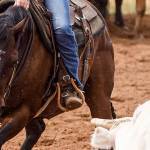Common Lamenesses in Western Performance Horses Identified

Certain injuries crop up consistently in horses engaged in the same discipline. As a group, western performance horses show lameness most often in the distal forelimbs, hocks, and stifles.
To improve our understanding of unsoundnesses sustained by western performance horses, one veterinary practice conducted 2,267 lameness examinations at national-level shows over a 10-year period.* Using standard lameness localization techniques and diagnostic analgesia (i.e., joint and nerve blocks), the veterinarians found the following:
- Lameness in western performance horses was most commonly (40% of cases) localized to the distal forelimb, i.e., the ankles and the structures beneath them;
- The hock was the second most common site of lameness (16% of cases);
- The stifle was the third most common site of lameness (9% of cases); and
- The source of a horse’s lameness could not be determined in only a few cases (2.2%).
According to the veterinarians, forelimb lameness in these horses could be related to repetitive concussive forces applied to characteristically small hooves, in the Quarter Horses specifically.
“Western breeds are often more upright in their pasterns, causing concussion at slower speeds. Also, many western pleasure horses are bred with straighter stifles, resulting in many issues, including the potential for soreness or unsoundness,” said David Nash, director of nutrition technology at Kentucky Equine Research.
In the hind limbs, osteoarthritis of the lower hock joints is commonly recognized in horses competing in barrel racing, team roping, reining, and cutting. Excessive compression and torque associated with sudden turns and stops, often at high speeds, are believed to contribute to and exacerbate the development of hock osteoarthritis.
“When starting young performance horses destined for events where the risk of developing osteoarthritis is relatively high, offering joint supplements to help slow the onset and progression of disease would be beneficial,” advised Nash.
Look for high-quality joint supplements that contain glucosamine, chondroitin sulfate, and hyaluronic acid. These joint products help counteract inflammation, reduce cartilage damage, and stimulate cartilage repair.
*Johnson, S.A., J.R. Donnell, A.D. Donnell, and D.D. Frisbie. 2020. Retrospective analysis of lameness localisation in western performance horses: A ten-year review. Equine Veterinary Journal:13397.








